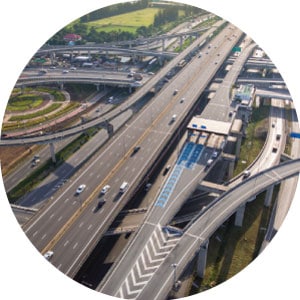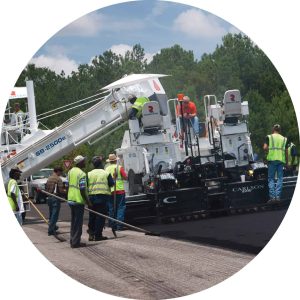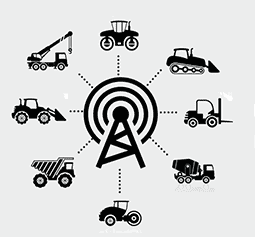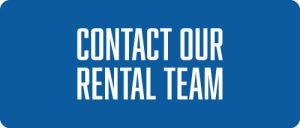Case Study: Telematics Coordinate Massive Highway Project
By now, most construction firms have come to appreciate the value of telematics built into newer equipment. The technology helps operators perform their work more comfortably and efficiently, and it helps the machine perform most efficiently, too. It monitors the machine in real time, instantly alerting operators and/or remotely located service techs to faults or other anomalies. And, of course, telematics technology provides a wealth of ongoing data owners can use to support equipment longevity.
But telematics can do even more, if you pool data from individual machines into a single, big picture resource. That’s how Colorado-based Atkinson Construction and Chicago-based Walsh Construction managed to efficiently manage a massive joint venture project in Southern California.
 The Project
The Project
The Atkinson-Walsh team won the design-build contract to handle highway and bridge work associated with a $1.4 billion project to expand and improve a stretch of California’s State Route 91 between Corona and Anaheim. They bid $632 million, with work to be completed over three years, from 2014 to 2017. They pulled it off, and they credit telematics for that success.
The Atkinson-Walsh joint venture won their bid not just on price but on the merits of their “innovative” proposal that included “alternative technical concepts”:
- Their plan for traffic control and project staging eliminated the traditional need to temporarily widen roadways.
- Their design for connecting the SR-91 express lanes with I-15 south trimmed the required bridge by 200,000 square feet.
- Their design required just two straddle bents to span SR-91, instead of the projected nine. Straddle bents are used in instances where a standard pier-supported span would interfere with the roadway itself.
The highway side of the project totaled about 48 lane miles of roadway:
- Extending existing express lanes (two lanes in each direction) another 8 miles
- Adding a general-purpose land in each direction
- Significantly modifying the existing SR-91/I-15 interchange
- Adding a tolled express lane in each direction on I-15, south of the remodeled interchange
There were 32 bridges involved in that component of the project. Karle says some had to be demolished and rebuilt from scratch, whereas others had to be widened. Some were brand new construction. The project also included construction of 100 retaining walls (about 1 million square feet in all) and sound walls totaling another 300,000 square feet.
 The Equipment
The Equipment
The physical scope of the job – about 10 miles — and the sheer amount of equipment required to do the work was mind-boggling. Atkinson’s equipment superintendent Tim Karle, who managed the joint-venture’s fleet, sums it up: “We had nearly 400 pieces of owned equipment on site and probably 200 rental pieces. During peak times, more than 750 craft employees were on the project, which was a 24/7 operation for the better part of 2-1/2 years.”
Specifically for this project, the joint venture purchased 250 Ford trucks (from F150 to F650 pickups) with factory-installed telematics and another 60 assorted pieces of equipment ranging from light plants and air compressors to telehandlers. These were retro-fitted with telematics by Atkinson.
Atkinson Is a Long-Time Proponent of Telematics
Atkinson Construction has relied on telematics since 2009, both on owned equipment and on rentals, so they brought that experience to the joint venture. Their only hope, says Karle, was to make sure every piece of motorized equipment was equipped with a telematics system. In the end, 98% of the fleet was connected. Integrating telematics-enabled Karle and his team, including service techs, to see where every machine was located at any given time.
“We worked with our rental companies to ensure that any piece of equipment that could use telematics was so equipped for use on the SR-91 project,” says Karle.
Although there were multiple telematics systems involved, all of the owned vehicles and equipment could be tracked on one screen, and all the rentals could be tracked.
How Telematics Streamlined Project Management
The joint venture used telematics data to ensure that all equipment stayed on its preventive maintenance schedule. If a machine generated a critical fault code, service techs were able to address that immediately. The rental company also provided an on-site mechanic as well as two trucks that were used to help transport equipment around the job site.
 The team also used telematics to make logistics more cost-effective. For example, during peak work periods, there were 45 telehandlers on the jobsite. “Just making sure all these machines were being used was a big task,” notes Karle. With the rental company’s telematics system, “we were able to see where we were on the monthly rental for these pieces. That capability alone saved a huge amount of money by helping us avoid keeping the machine into the next rental period if it wasn’t needed.”
The team also used telematics to make logistics more cost-effective. For example, during peak work periods, there were 45 telehandlers on the jobsite. “Just making sure all these machines were being used was a big task,” notes Karle. With the rental company’s telematics system, “we were able to see where we were on the monthly rental for these pieces. That capability alone saved a huge amount of money by helping us avoid keeping the machine into the next rental period if it wasn’t needed.”
In addition, the GPS aspect of telematics enabled Karle and his team to “see” every piece of equipment even if it was literally out of sight. Any driver who needed to pick up a machine to take it to another part of the job could simply pull up the location on their smartphone.
They set usage thresholds for units and created weekly usage reports. With light towers, for instance, if they saw a unit hadn’t been used for a couple of days, they could move it to another location rather than paying to have it just sit. In some cases, they determined that rental equipment was racking up more hours than owned equipment. They could reverse that to save money.
Telematics enabled Karle’s fleet management team to track machine hours of operation, fuel usage, and idle time. By calling attention to over-idling, they were able to save more money.
The joint venture was also used telematics to set geo-fencing parameters on equipment, something they credit with helping minimize theft from the jobsite.
What Does This Mean for You?
The bigger or more spread-out a job, the harder it is to manage efficiently. But any size project and any size fleet can benefit from greater performance and streamlined processes. Coordinating telematics could be the way to make your next job more productive and, in the end, more profitable.

